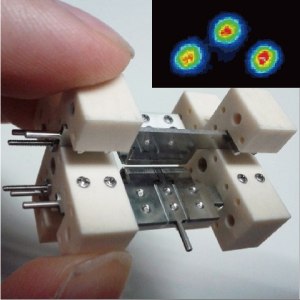Although quantum tunneling is a unique quantum-mechanical phenomenon, a tunneling particle has yet to be measured directly and many quantum mysteries remain. A tunneling particle can be coupled to an electromagnetic field, but coupling between a tunneling particle and the vector potential of an electromagnetic field, which is known as the Aharonov-Bohm effect1), was only recently demonstrated. The Urabe group at Osaka University and Yutaka Shikano*, who is a research associate professor at the Research Center of Integrative Molecular Systems (CIMoS), Institute for Molecular Science, observed this effect with quantum tunneling. Their work was published in Nature Communications.
Our experimental setup at Osaka University uses an ion trap system (Fig. 1). Ion traps have potential in quantum computers and quantum simulations. In particular, a linear Paul trap, which is the type of ion trap in our experiment, has a high scalability in a one-dimensional quantum system due to advances in quantum information technology. Although cooling of the two-dimensional ion structure has been an obstacle in a linear Paul trap, we found that the ground state of the ion’s rotational motion can be manipulated using a laser cooling technique. This new quantum technology allows a linear Paul trap to be used in two-dimensional quantum simulations and quantum computations.
In addition, we discovered the rotational mode near the ground state for three calcium ions arranged in a triangular structure where the ions are 6.8-μm apart. The two ground state structures (upward and downward triangles) can be considered quantum rotors, which are commonly used in molecular science to represent diatomic molecules, with a quantum-tunneling region. The transition between the two structures is due to quantum tunneling, even in the large tunneling region. Because clockwise and anticlockwise transitions are indistinguishable, this system can be viewed as a double-slit experiment. Changing the strength of the magnetic field oscillates the transition probability. This oscillation can be predicted by the Aharonov-Bohm effect.
In the future, we plan to elucidate more quantum mysteries by applying recently developed quantum information science techniques to quantum foundations.
Keyword
1) Aharonov-Bohm Effect
The Aharonov-Bohm effect, which was proposed by Yakir Aharonov and David J. Bohm in 1959, shows that the state of a charged particle can change even in a region without an electromagnetic field. This effect is inconsistent with classical electromagnetism, which predicts that the state of a charged particle can only be changed by an electromagnetic field. The state change is due to coupling between a charged particle and the vector potential of the electromagnetic field. In a double-slit experiment, the interference pattern changes. In 1986, Akira Tonomura and coworkers experimentally demonstrated evidence for the Aharonov-Bohm effect in the free barrier region by electron holography, which is a key technology for the electron microscope.
Reference:
Title: Aharonov–Bohm effect in the tunnelling of a quantum rotor in a linear Paul trap
Authors: Atsushi Noguchi (Osaka University, current position: University of Tokyo), Yutaka Shikano, Kenji Toyoda (Osaka University), and Shinji Urabe (Osaka University)
Journal: Nature Communications 5, 3868 (2014).
“Aharonov–Bohm effect in the tunneling of a quantum rotor in a linear trap”
Date: Published online March 13, 2014, doi: 10.1038/ncomms4868
*Affiliate member of the Institute for Quantum Studies, Chapman University, USA.

Our trap system (linear Paul trap) and the triangle structure of three calcium ions
1601

